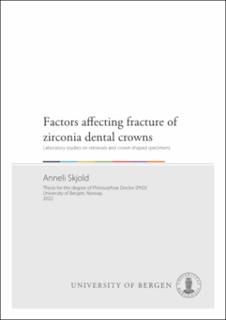| dc.contributor.author | Skjold, Anneli | |
| dc.date.accessioned | 2022-08-15T07:50:52Z | |
| dc.date.available | 2022-08-15T07:50:52Z | |
| dc.date.issued | 2022-09-02 | |
| dc.date.submitted | 2022-08-02T22:37:48.308Z | |
| dc.identifier | container/84/e0/a1/03/84e0a103-de86-4515-a89d-f0b6ed04e9bb | |
| dc.identifier.isbn | 9788230853528 | |
| dc.identifier.isbn | 9788230842287 | |
| dc.identifier.uri | https://hdl.handle.net/11250/3011756 | |
| dc.description.abstract | Objektiv: De siste 20 årene har bruken av zirkonia som dentalt materiale har økt betydelig. Laboratorietester som undersøker materialstyrke, indikerer at de tilgjengelige zirkonia-materialene har tilstrekkelige mekaniske egenskaper til å tolerere klinisk bruk. Imidlertid, kliniske studier viser at zirkonia-baserte kroner svikter grunnet totalfraktur og mindre avskallinger. Det er lite informasjon tilgjengelig om den underliggende årsaken og mulige faktorer som påvirker en kronefraktur.
Mål: Hovedmålet med denne oppgaven var å undersøke frakturdetaljer hos klinisk knekte zirkonia-baserte kroner og å identifisere faktorer som kan påvirke fraktur hos zirkonia-baserte kroner.
Materialer og metoder: Klinisk knekte zirkonia-baserte kroner ble levert/sendt inn av allmenntannleger og undersøkt vha fraktografisk metode. I to laboratoriestudier ble det undersøkt hvordan ulike faktorer som kronematerialtykkelse, preparasjonstype, produksjonsmetode, materialsammensetning og aldringsprosedyrer påvirket bruddverdi ved belastning hos zirkonium-kroner.
Konklusjoner: Fraktografisk analyse viste at de fleste knekte kronene hadde frakturstart ved kronekanten. Dette indikerer at kronekanten hos zirkonia-baserte kroner er utsatt for forhøyet belastning. Materialtykkelse og sammensetning hadde effekt på bruddverdien til zirkonia-baserte kroner. Aldringsprosedyrer som simulerte kortvarig klinisk bruk påvirket ikke bruddverdier, uavhengig av materialsammensetning. | en_US |
| dc.description.abstract | Objective: The use of zirconia material in dental use has increased significantly over the last 20 years. Laboratory tests that examine material strength and toughness indicate that the available zirconia materials have sufficient mechanical properties to tolerate clinical use. However, clinical studies show that zirconia-based crowns fail due to mechanical failure such as fracture and chipping. There is little information available on the underlaying cause and possible factors affecting a crown fracture.
Aim: The main aim of this thesis was to examine fracture details of zirconia-based crowns fractured during clinical use and to identify factors that could affect fracture of zirconia dental crowns.
Material and methods: A convenience sample of clinically fractured zirconia-based crowns submitted by general dentists were analyzed by fractographic method. Two laboratory studies assessed how different factors such as crown material thickness, preparation type, production method, material composition and aging procedures affected load at fracture for zirconia crowns.
Conclusions: Fractographic analysis showed that most fractured crowns had fracture origin at the crown margin and thus indicating an area of increased load during clinical use. Zirconia material thickness and material composition had an effect on load at fracture. However, aging procedures simulating short-term clinical use did not affect the load at fracture values, regardless of material composition. | en_US |
| dc.language.iso | eng | en_US |
| dc.publisher | The University of Bergen | en_US |
| dc.relation.haspart | Paper I: Skjold, A., Schriwer, C., Gjerdet, N.R., Oilo, M.: “Fractographic analysis of clinically fractured bi-layered and monolithic zirconia crowns”. The article is not available in BORA. | en_US |
| dc.relation.haspart | Paper II: Skjold, A., Schriwer, C., Oilo, M. (2019): “Effect of margin design on fracture load of zirconia crowns”, Eur J Oral Sci; 127: 89-96. The article is available at: <a href="https://hdl.handle.net/1956/23155" target="blank">https://hdl.handle.net/1956/23155 </a> | en_US |
| dc.relation.haspart | Paper III: Skjold, A., Schriwer, C., Gjerdet, N.R., Oilo, M. (2020): “Effect of artificial aging on high translucent dental zirconia: simulation of early failure”, Eur J Oral Sci; 128: 526-534. The article is available in the thesis file. The article is also available at: <a href=" https://doi.org/10.1111/eos.12739" target="blank">https://doi.org/10.1111/eos.12739 </a> | en_US |
| dc.rights | In copyright | |
| dc.rights.uri | http://rightsstatements.org/page/InC/1.0/ | |
| dc.title | Factors affecting fracture of zirconia dental crowns : Laboratory studies on retrievals and crown-shaped specimens | en_US |
| dc.type | Doctoral thesis | en_US |
| dc.date.updated | 2022-08-02T22:37:48.308Z | |
| dc.rights.holder | Copyright the Author. All rights reserved | en_US |
| dc.contributor.orcid | 0000-0001-6567-6499 | |
| dc.description.degree | Doktorgradsavhandling | |
| fs.unitcode | 13-19-0 | |
